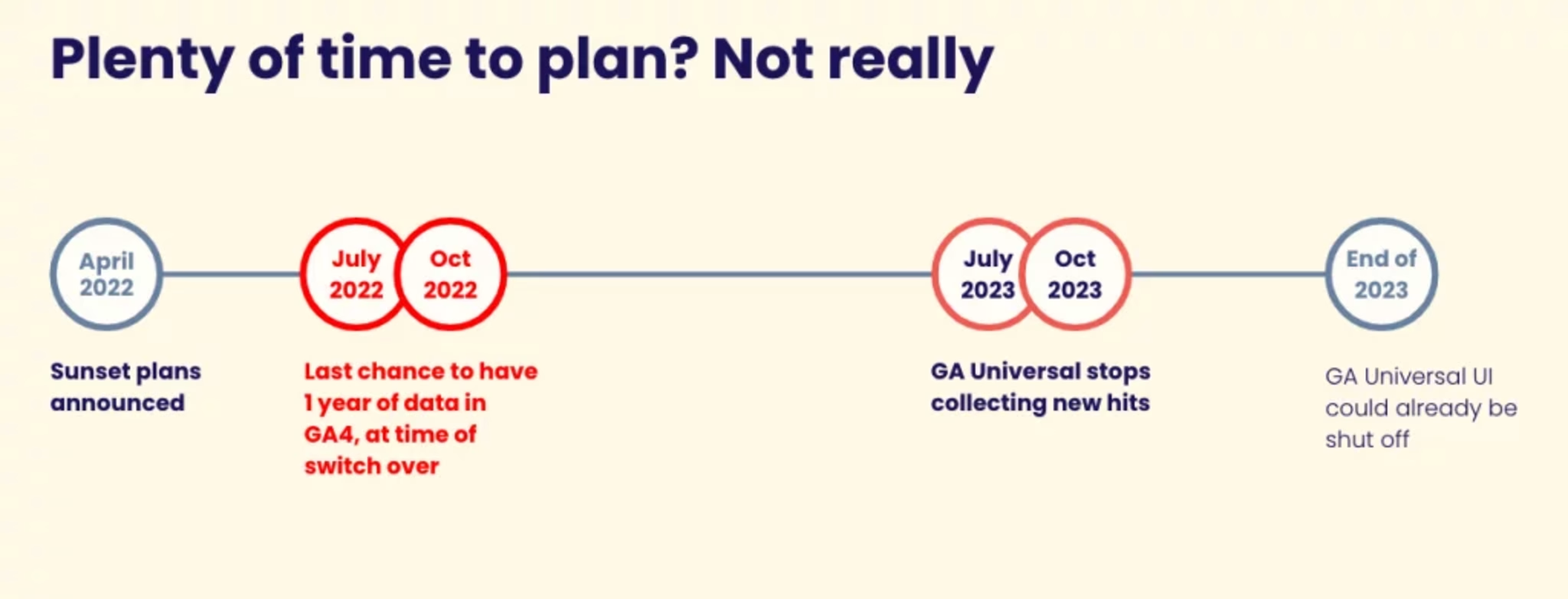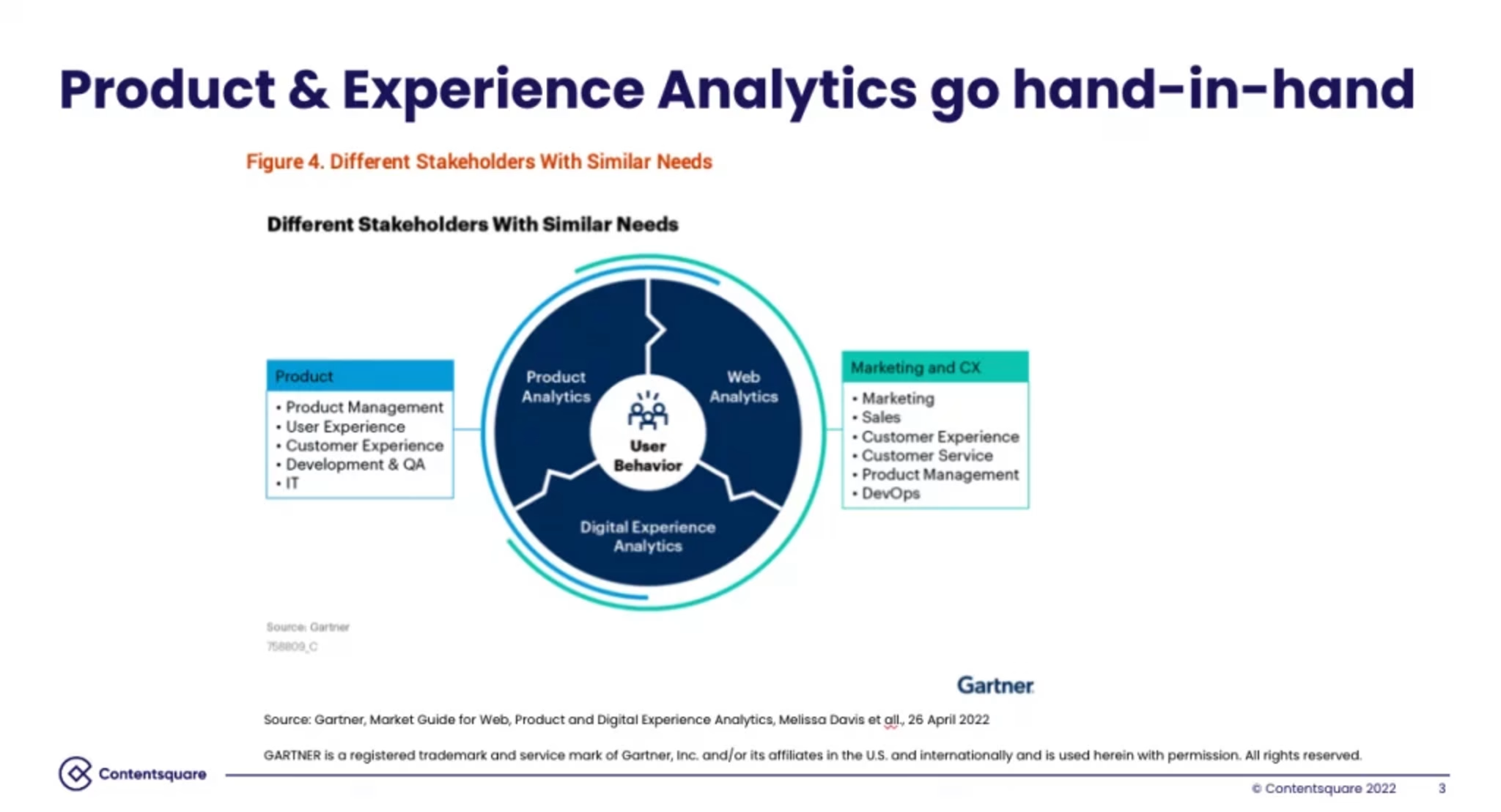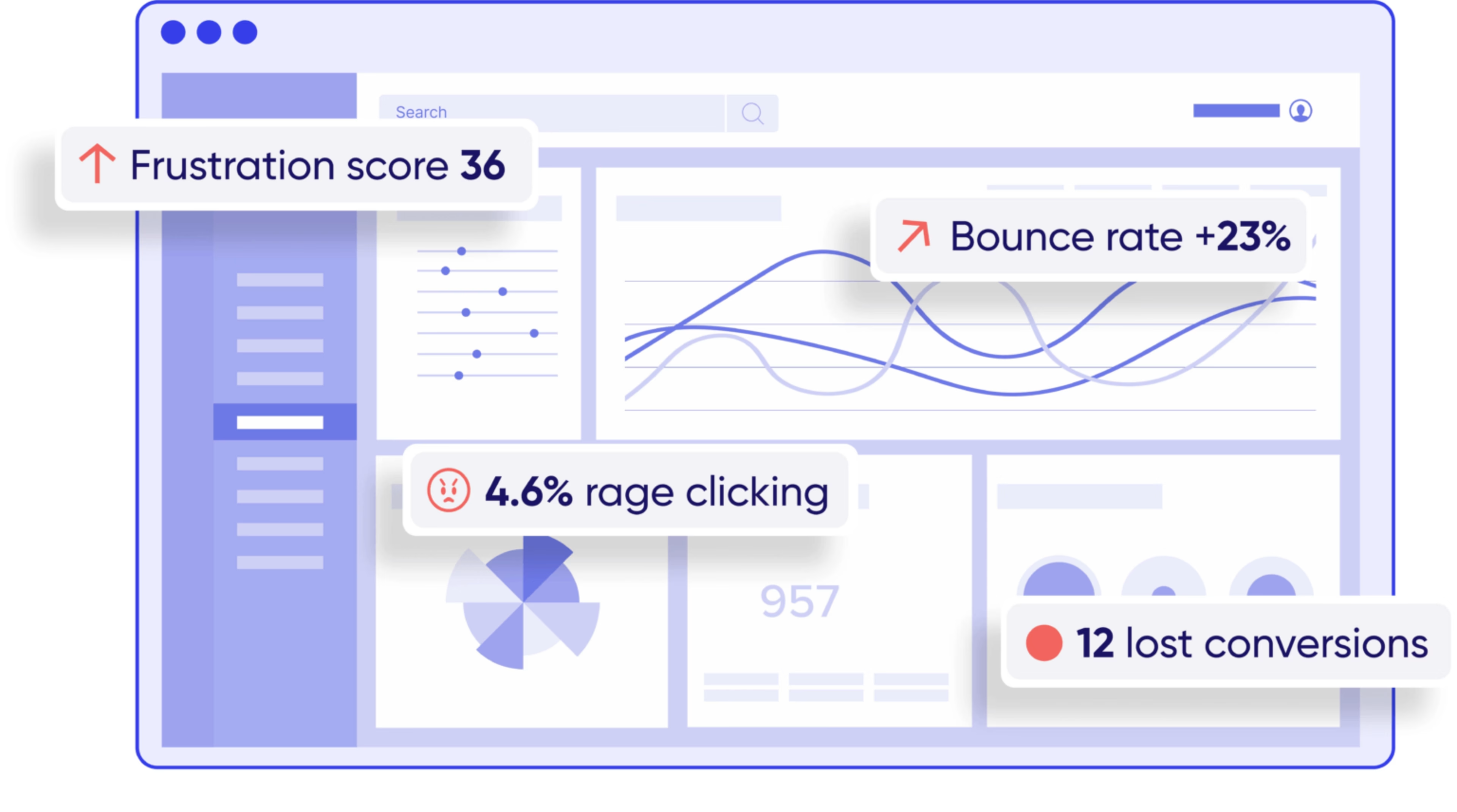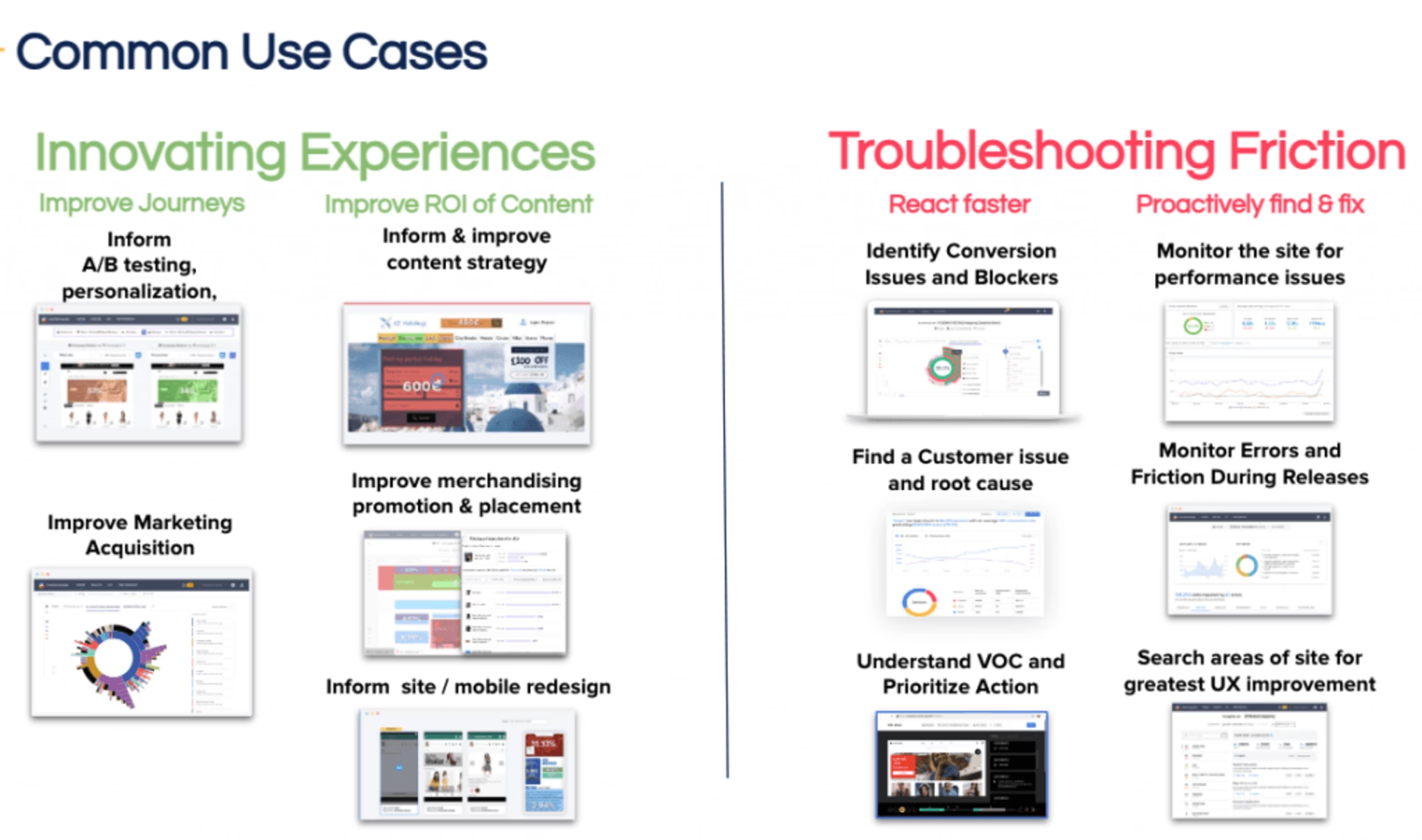The race is on! With the looming sunset of Google Analytics Universal Edition on July 1, 2023, millions of sites will be re-platforming to Google Analytics (GA4) this year. It’s the biggest re-tagging and re-platforming “fest” for digital intelligence professionals ever. We should plan a big party when it’s all done!
So, here are our tips on how to de-risk your journey to GA 4 and how digital experience analytics can help:
TABLE OF CONTENTS
Google Analytics 4 (GA4) is a great thing to happen. a big job to get done
Start yesterday, not next year
Take advantage, don’t just try to mirror what you had on Google Analytics Universal
Make your re-platforming easier — combine GA with Digital Experience Analytics
Digital Experience Analytics helps de-risk the switch-over to GA4s
1. Google Analytics 4 (GA4) is a great thing to happen. But it’s also a big job to get done.
Yes, the re-platforming is going to be a big job to get done. But it’s also a great thing. Google Analytics 4 will eventually be more powerful than the old GA. Don’t let the current commentary on the Internet weigh you down.
The Internet is awash with commentary about the challenges of the upcoming migration. Many articles mention the changes and current shortcomings with GA4. It’s understandable.
For example:
GA4 requires deploying a whole new tag. Retagging is never fun
It’s not “just retagging”, but the opportunity is to tag in-page behavior events at a much finer grain of detail. More to that further down in this post. But, bottom line, to take full advantage, it’s going to be a much bigger tagging job than you’ve ever done for Google Analytics.
The tagging is not retroactive. If you want to answer a question but didn’t pre-plan the necessary tags for capturing the related events, you will be blocked.
All your old Google Analytics data will eventually go away. GA4 means starting fresh from zero data in your new account.
All your integrations will need to be redone. Period.
Many familiar metrics are changing. For example, Bounce Rate is replaced with the Engagement Rate, as defined by Google. Again, this too is a good thing. Why? It gives you more detail on how often users bounce without even staying 10 seconds. So, if a user had the page open for more than 10 seconds it is at least leaving the door open that they might have read the landing page content, at least. But if you were measuring yourself towards improving bounce rates, you will just need to recalibrate your benchmark metric.
Any custom reports and dashboards will need to be redone. In fact, as of now, even some of the out-of-box reports that were available in GA will need to be created manually in GA4.
All your users will need to be retrained.
No wonder, everyone is nervous.
And we’re not just talking about some “nice to have” dashboard here. After all, Web Analytics is the heart of digital intelligence measurement. And, Digital is mission-critical for brands and businesses because … life is digital today.
2. Start on GA4 today yesterday, not next year
The sunset of the old GA is only July 1 2023, right? And for GA 360 commercial customers it is only October 2023. So we’ve got plenty of time, right?
Nope.
You surely want to be able to compare data year over year in GA4, right? It’s critical for understanding what metrics and fluctuations are normal for that time of year vs. unusual.
But to have 1 year of data in GA4 before data collection into the old GA stops, you need to be up and running in GA4 now, in June/July 2022
“:OK, but can’t I compare to my old GA data which will still be accessible for a long time after data collection stops into the old GA?”
Nope. Remember how your metrics will be fluctuating? Comparing GA4 metrics to GA metrics for baseline could be a big mess.
Don’t wait, implement GA4 now!
Hopefully, you are one of those sites that implemented GA4 a long time ago.

3. Take full advantage of GA4, don’t just mirror what you had on Google Analytics Universal
GA4 is Google’s foray into Product Analytics, i.e. in the direction of solutions such as Amplitude, Mixpanel, Heap, and Pendo.
What the heck is Product Analytics?
Going beyond the old Web Analytics paradigm, Product Analytics tracks behaviors with a much finer grain of detail. That includes clicks on in-page elements and cross-session behaviors.
The purpose is to help Product teams understand which of the features within their website and app pages are being adopted by their users. You can also see how clicks on those features translate into journeys and value.
The benefit is for example to help product managers decide which features to invest in vs. eliminate
Gartner’s newest Market Guide for Web, Product, and Digital Experience Analytics from April 2022 calls out how these three types of digital intelligence go hand in hand. See their chart in the image below. Gartner calls out increasing convergence between the three adjacent digital intelligence types.

Source: Gartner, Market Guide for Web, Product and Digital Experience Analytics, Melissa Davis et all., 26 April 2022.
But to get the product analytics benefits from GA4, you’ll need to tag behaviors at a finer grain than just pageview level. Instead, you add click event tags for any in-page behavior that you want to track and manage.
This is something you’ll want to pre-plan because data is not retroactive. Any in-page behavior tag that isn’t there, means that you won’t be able to answer questions about that behavior afterwards.
So … after implementing the base GA4 now, you will want to think carefully about which question you want to answer about in-page clicks and pre-plan event tags for those.
This is probably best accomplished with a crystal ball where you can see into the future and anticipate all of the questions your entire team will throw at GA4? Then you can just deploy the tags needed to answer them,
Or, maybe you have a time machine? If you did not anticipate a tag that was needed, you can just jump into the time machine and go back to 2022 to add the missing tags?
Just kidding of course.
So, what do you do instead?
4. Make your re-platforming easier — combine GA4 with Experience Analytics
As Gartner calls out in their market guide referenced above, all stakeholders benefit from combining Web, Product, and Experience Analytics. That’s also true during your re-platforming to GA4.
What the heck is (Digital) Experience Analytics?
Experience analytics goes beyond Web and Product Analytics in its capture of behaviors, It provides a more holistic understanding of user behaviors including everything that happens in between clicks. And arguably, 95% of behavior on a site or app is happening between clicks, e.g.
Scrolling
Engagement
Hesitation
Confusion
Frustration
Errors
Ultimately, DXA provides a more holistic understanding of customers, and their intent. and experiences. That opens up a new approach for brands to compete in providing differentiated digital experiences.
And unlike typical Web and Product Analytics, Digital Experience Analytics captures these behaviors automatically and retroactively, without needing to deploy event tags.
So you can retire your crystal ball and time machine. Not needed anymore.
For example, Contentsquare, the market-leading Digital Experience Analytics platform for enterprises, automatically captures all interactions with dynamic content elements so brands can later decide what questions to ask and answer.
Just as Gartner suggested, DXA is not used instead of Web or Product Analytics, but it is typically used together with them. They go hand in hand.
Build better products and better experiences.
Why Digital Experience Analytics during Re-Platforming to GA4?
Now, here is the beef. Here are five good reasons why everybody’s life will be better when you’ve got DXA in place before and during re-platforming to GA4.
1. Answer new questions with freedom from tagging.
No need to pre-plan tags. When questions arise that you didn’t anticipate, your business users will get answers. DXA doesn’t depend on pre-planning tags.
2. Provide intuitive visuals and insights for business users.
Your business users have a lot of new metrics and reports to get used to in GA4. During this switch-over, the intuitive visuals provided by DXA will go a long way toward helping answer questions about customers and their experiences. For example, Journey Analysis, Heatmaps, and Session Replay.
With Live browsing, DXA enables business users to just browse their own website and overlay metrics with a click. What could be easier than that? It enables answering questions in the moment when answers are needed during a meeting.

3. Get an independent third-party baseline for your metrics while you recalibrate
Your metrics will fluctuate in the switch-over from GA to GA4. But which is more accurate? Having a neutral third source of insights will make it easier to triangulate answers to questions. Literally.
4. All the usual reasons why Web and Product Analytics are combined with Digital Experience Analytics
For example, here is a view of synergetic use cases:

And reason 5 follows below.
5. Digital Experience Analytics helps de-risk the switch-over to GA4s
If something goes wrong on your journey towards GA4, and you cannot answer a question during the switch-over to GA4, Digital Experience Analytics will cover your back. It’s a bit like signing up for trip insurance before this summer’s vacation.
Digital Intelligence is too mission critical to leave anything to chance. To err is human. But that cannot be a reason for your business to suffer.
That’s why you want to back up your re-platforming process to GA4 with Digital Experience Analytics.
![[Visual] laptop with Google](http://images.ctfassets.net/gwbpo1m641r7/5UA8GHrtJ2Yr3MjrvdF87V/427a917c22cb8bbb3311703a058c66ba/pexels-pixabay-38547-1-scaled-1.jpg?w=3840&q=100&fit=fill&fm=avif)
![[Visual] Akin Arikan](http://images.ctfassets.net/gwbpo1m641r7/7ED3mAxIMNPmGx7KIxfBIt/0bd5f8d691e7a4edb515fafc81bfe32d/T027K0ZC9-U6DQF5DPD-de47e6381bbd-512.png?w=1080&q=100&fit=fill&fm=avif)